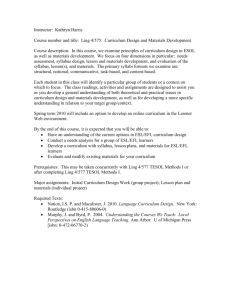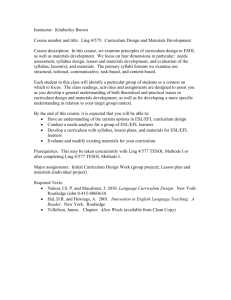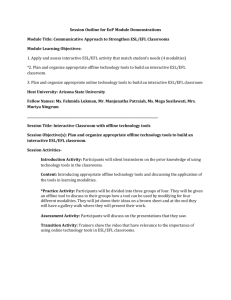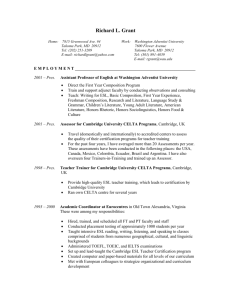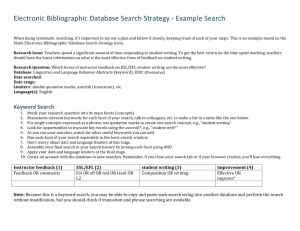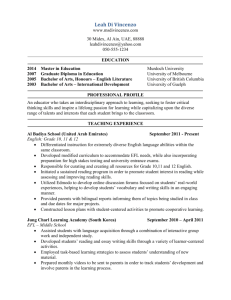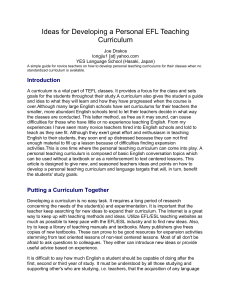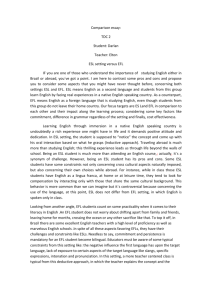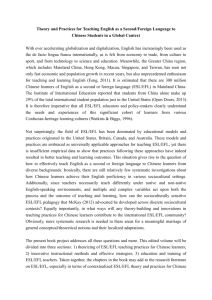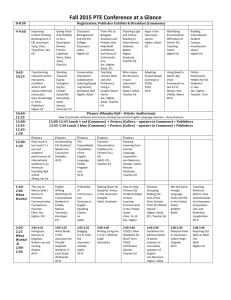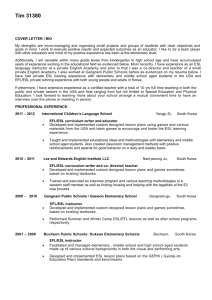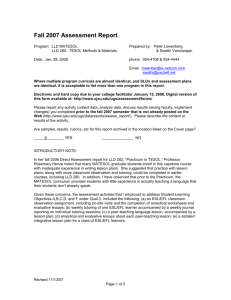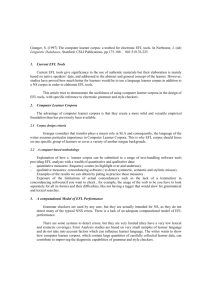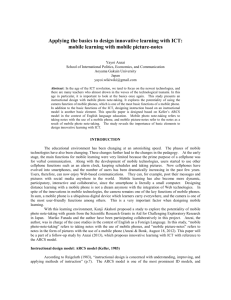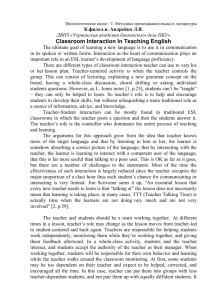Course Evaluation
advertisement
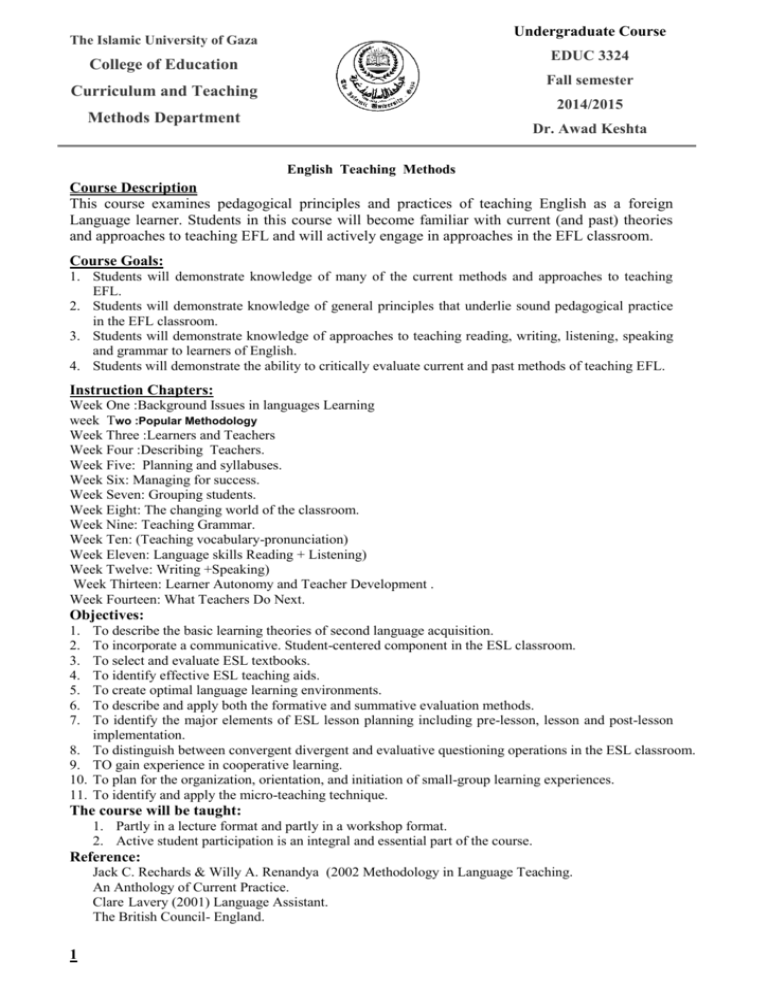
Undergraduate Course The Islamic University of Gaza EDUC 3324 College of Education Fall semester Curriculum and Teaching 2014/2015 Methods Department Dr. Awad Keshta English Teaching Methods Course Description This course examines pedagogical principles and practices of teaching English as a foreign Language learner. Students in this course will become familiar with current (and past) theories and approaches to teaching EFL and will actively engage in approaches in the EFL classroom. Course Goals: 1. Students will demonstrate knowledge of many of the current methods and approaches to teaching EFL. 2. Students will demonstrate knowledge of general principles that underlie sound pedagogical practice in the EFL classroom. 3. Students will demonstrate knowledge of approaches to teaching reading, writing, listening, speaking and grammar to learners of English. 4. Students will demonstrate the ability to critically evaluate current and past methods of teaching EFL. Instruction Chapters: Week One :Background Issues in languages Learning week Two :Popular Methodology Week Three :Learners and Teachers Week Four :Describing Teachers. Week Five: Planning and syllabuses. Week Six: Managing for success. Week Seven: Grouping students. Week Eight: The changing world of the classroom. Week Nine: Teaching Grammar. Week Ten: (Teaching vocabulary-pronunciation) Week Eleven: Language skills Reading + Listening) Week Twelve: Writing +Speaking) Week Thirteen: Learner Autonomy and Teacher Development . Week Fourteen: What Teachers Do Next. Objectives: 1. 2. 3. 4. 5. 6. 7. 8. 9. 10. 11. To describe the basic learning theories of second language acquisition. To incorporate a communicative. Student-centered component in the ESL classroom. To select and evaluate ESL textbooks. To identify effective ESL teaching aids. To create optimal language learning environments. To describe and apply both the formative and summative evaluation methods. To identify the major elements of ESL lesson planning including pre-lesson, lesson and post-lesson implementation. To distinguish between convergent divergent and evaluative questioning operations in the ESL classroom. TO gain experience in cooperative learning. To plan for the organization, orientation, and initiation of small-group learning experiences. To identify and apply the micro-teaching technique. The course will be taught: 1. Partly in a lecture format and partly in a workshop format. 2. Active student participation is an integral and essential part of the course. Reference: Jack C. Rechards & Willy A. Renandya (2002 Methodology in Language Teaching. An Anthology of Current Practice. Clare Lavery (2001) Language Assistant. The British Council- England. 1 Workshop Handouts in Practical Teaching (2009)-Palestine. The Practice Of English Language Teaching. Forth Edition- Jeremy Harmer. Office Hours: Saturday, Monday 11:00 am -1:00 Pm Wednesday: 11:00 pm –1:00 pm Course Requirements: 1. Active participation is required. 2. Each student is required to complete all assignments given him or her by the instructor. 3. Research paper. 4. Regular attendance is expected and needed. 5. Micro- teaching project. 6. Lesson planning . GOALS OF DIFFERENTIATED INSTRUCTION: Differentiated instruction enhances learning for all students by engaging them in activities that better respond to their particular learning needs, strengths and preferences. The goals of differentiated instruction are: - To develop challenging and engaging tasks for each learner - To develop instructional activities based on essential topics and concepts, significant processes and skills, and multiple ways to display learning - To promote flexible approaches to content, instruction and products - To respond to students’ readiness, instructional needs, interests and learning preferences - To provide opportunities for students to work in varied instructional formats - To meet curriculum standards and requirements for each learner DIFFERENTIATED INSTRUCTION MEANS: - Recognizing the learning diversity represented in today’s classroom - Affirming that students have different learning needs, strengths, styles, interests and preferences - Maintaining a commitment to curriculum standards and learning goals for all students - Increasing the variety in teaching, learning and assessment in order to reach more students and respond to their preferences, styles, interests, and strengths - Providing high levels of challenge and active engagement in rigorous, relevant, and significant learning Course Evaluation - . 2 : Professional Development Papers Using and sharing Module + Writing Summary Quizzes 5% 5% 5% Attendance and Participation 01% Micro-teaching project 5% Med Term Exam Final Exam 20% 50%

